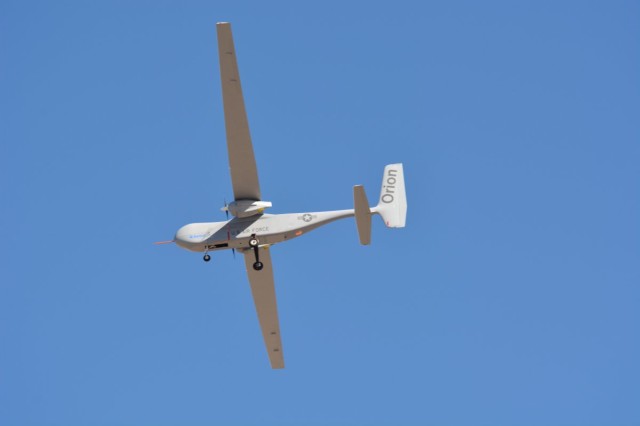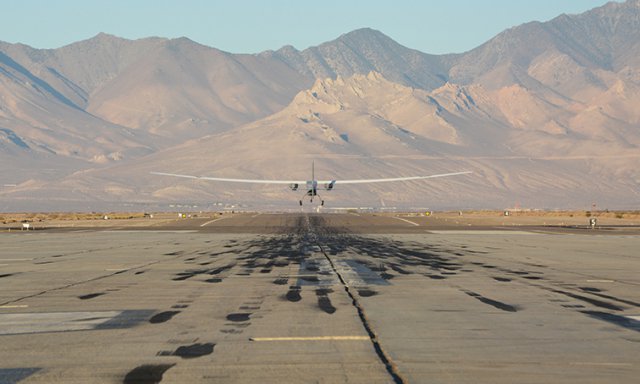It began life as a hydrogen-fuelled, high-altitude unmanned aircraft but evolved into a diesel-powered platform designed to fly at medium altitude for five days and promising dramatically reduced operating costs compared with today’s Predator-class UAVs.
Now that Aurora Flight Sciences’ Orion has shown its ultra-long-endurance potential, the company has filed for a world endurance record following an 80-hr. flight last month. This compares directly with the record of 30.4 hr. set by the Northrop Grumman RQ-4 Global Hawk in 2001 and is a step toward the 120-hr. goal.
The flight took place on Dec. 5-8 over the China Lake weapons range in California under a U.S. Air Force concept demonstration programme. The record is expected to be ratified within weeks by the National Aeronautic Association, which witnessed the flight, says Aurora CEO John Langford. He says the record flight has renewed interest in the Orion, which is designed to reduce the manpower burden and operating costs for medium-altitude long-endurance (MALE) UAS by flying for five times as long as a Predator-class UAS.
In setting the record, Aurora met a requirement under its fixed-price demonstration contract to perform an 80-hr. flight by Dec. 19. “We budgeted three attempts and achieved it on the second,” Langford says. The first attempt ended when the aircraft had to turn back after 3 hr. to reset its flight termination system.
The record flight was conducted at 4,500-10,000 ft. above mean sea level, the Orion carrying 1,000 lb. of ballast to represent its design payload. Endurance was limited by range availability, the aircraft landing with about 1,700 lb. of fuel remaining—enough for an additional 37 hr. of flying, Langford says.
The December flight was the 18th for the Orion, which has logged 158 flight hours, reaching altitudes up to 18,000 ft. Demonstration of the design 120-hr. endurance at 20,000 ft. carrying a 1,000-lb. payload is planned for later this year.
Aurora was selected by the Air Force Research Laboratory in 2007 for the Ultra Long Endurance study contract to look at fixed-wing alternatives to the surveillance airships then being explored and push beyond the 24-30-hr. endurance limits of Predator and Global Hawk.
The Air Force Blue Devil 2 and Army Long Endurance Multi-Intelligence Vehicle surveillance airships ultimately were canceled. But in 2009, Aurora won a joint-capability technology demonstration contract to build the Orion, which made its first flight in August 2013.
When design began, the Orion was intended as a single-engine, hydrogen-fuelled, high-altitude, long-endurance unmanned aircraft. It was subsequently redesigned as a MALE UAS powered by two fuel-efficient Austro Engine turbo-diesel aero engines burning jet fuel.
Originally, Orion was to carry a 400-lb. payload to 65,000 ft. and had a 7,000-lb. gross weight. The redesign to carry a 1,000-lb. payload to 20,000 ft. increased the gross weight to 11,000 lb., and Aurora built a second, stronger wing, which was fitted to Orion after its initial flights to allow full airworthiness certification.
“We are pleased with the aerodynamic performance of the wing and the performance of the engines, which are at or very close to the design point,” says Langford. “The autonomy is amazing: You just taxi it into place and hit the launch button. There is no stick and no provision for manual reversion. You can put it into ‘knobs’ mode to change heading, altitude or airspeed, but there is no opportunity to take it over. It is fully automatic.”
The four pilots operated Orion over the duration of its record flight were Peter Lehew, Cody Allee, Joel Walker and Dave Gerhardt.
Flight tests, which are being managed by the Air Force’s Big Safari programme, are using the U.S. Army’s AAI Corp. One System ground station and Common Data Link. The aircraft has a triple-redundant flight control system developed and tested by Aurora on its Centaur optionally piloted aircraft.
The next steps for the programme are missionization and demonstration flights this year with a representative electro-optical/infrared sensor payload selected by the Air Force. But so far the Air Force has no plans for Orion beyond the concept demonstration.
“Additional flight testing is planned and funded . . . [but] there is currently no plan for procurement of Orion,” says the Air Force, as there is “no formal requirement” for the aircraft. “An operational deployment is not within the current scope of the demonstrator test program.”
Langford says Aurora is ready to build additional aircraft, if required. “We see opportunities in persistent communications and persistent surveillance. Orion brings that in reach with five days’ endurance, carrying 1,000 lb. With a smaller payload, we can go out to around a week,” he says.
“It is all about bringing down the cost of persistent surveillance or communications through aircraft efficiency, low acquisition cost, and reducing the cost of training and of staying proficient,” he notes.
Orion testing, including the 80-hr, record flight, “shows that promise is real and reachable,” Langford adds.
Photos: Aurora Flight Sciences
Source: Press Relaese, Aviation Week


